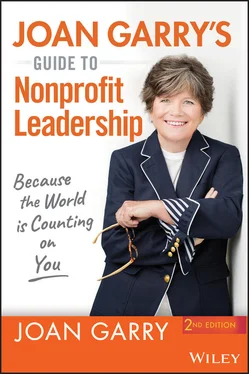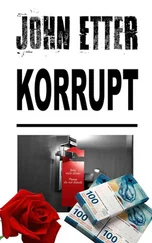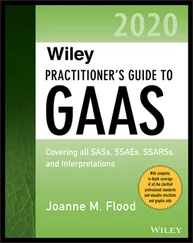See the board as a resource and invest time and energy in building a committed and diverse group. Be an active member of the board recruitment committee from day one. And seek out strong co‐chairs and consider them partners. Avoid the “yes” folks. Strong chairs will give you great advice and ask tough questions. Try not to get defensive, and this pushback will make you a more effective leader.
Once your organization stops teetering (see the preceding steps), budget money annually to build a reserve. Once you are able to pull your nose out of the cash flow worksheet, you can actually think ahead. So get to it. Where are the gaps? Are there constituents you are not serving that no other organization can serve as well as you? These conversations can lead to smart and bold strategies and fundable plans for the future.
This is how to dig out, how to stabilize, how to thrive. This is the core of my advice to many of my clients, to the thousands who visit my blog weekly, and to the dozens who write weekly with questions. And this captures the spirit of the advice I hope will be valuable to you.
But the single most important attribute of a nonprofit leader (board member or staff leader) — the attribute that is most critical in helping you to untangle knots, and the one that can move your organization from good to great — is joy.
In my own experience as a staff leader and a board leader along with work with all my clients I have had through the years, it is this attribute that creates standout leaders. They get it. It is a joy to be paid to advocate, feed the hungry, to change laws, to raise money, to create a strong infrastructure — all in the service of others.
I believe deeply in the power of the nonprofit sector to change the world in ways large and small. If you have raised your hand to say “I want to help; I want to work here; I want to volunteer; I want to raise money for you,” you are, in my book, nobility .
Your work says something important about your character, your spirit, your commitment to a fair and just world, your integrity, your courage, your grit, and your perseverance.
Not everyone makes this choice. Far too many people with time, connections, and capacity sit on the sidelines.
You made a different choice.
Your feet are firmly planted on the high road. And know that you are admired.
By many. Including me.
I speak from experience. Traveling on the high road isn't easy and it's messy, but if you love your organization, it's worth every minute.
Nonprofits are messy. Not enough money. Too many cooks. An overdose of passion.
Leading nonprofits isn't easy.
I'm here to help. I'm offering this book to share some of the most valuable lessons I've learned over my career.
I'm also providing a free collection of valuable templates, checklists and other downloadable resources at JoanGarry.com/resources.

Chapter 1 The Superpowers of Nonprofit Leadership
Dear Joan:
I've been with my organization for nearly 8 years, most recently in a development role. My predecessor has been the voice and face of the organization for nearly 25 years and has just retired. The board has offered me the ED position .
This would be alien territory for me. I've been the relationship guy, and I keep the trains running on time .
And the truth is, I'm not exactly sure what I would be getting into. I want to give this a go but I think I need help and would like to retain you as a coach .
My goal is simple: I want to learn to behave like an executive director .
Signed,
ED “E.T.”
“To behave like an executive director.” A very good goal for an executive director, I might add.
E.T. became a client, and we teased out exactly what he meant by this.
To be a leader and not a department head. To worry about the whole organization and every stakeholder. To stare at cash flow and wonder about payroll. To take responsibility for partnering with the board so that its members can fulfill their obligations. To stand up at a gala and give an inspiring and motivational speech. To feel an overwhelming sense of responsibility for the communities you serve.
It's a hard role to be in and a hard role to cast for. I am currently working with a board that cannot agree on the role the executive director should play (and they are already interviewing candidates!). (Can you say “cart before the horse?”)
Who should a board be looking for? What matters? In small organizations, the staff leader really does do it all. A person who can inspire a group with her words and read a balance sheet? What skills and attributes matter? Do you have them? How do you cultivate them?
And the decision is so important. In my experience, leadership transitions are the most destabilizing forces in a nonprofit organization. Try raising money when you are between executive directors. Nuff said.
What's interesting is that all these same issues and questions apply to board chairs as well. What should an organization be looking for in a board chair? (Note: the correct answer is not “pray that someone raises her hand and pick her.”) How might the skills and attributes of that person complement those of the staff leader? What skills and attributes matter? How do you cultivate them?
Before I give you the answer to these questions, let's try a little quiz. Are you currently a nonprofit ED, overwhelmed by the idea that you need to be all things to all people? A board chair enthusiastic about leading the board to support the staff? Or someone who aspires to change the world and make the for‐profit to nonprofit leap?
The quiz should put things into perspective and begin to reveal the superpowers you need to be an effective leader within a nonprofit.
So riddle me this, Batmen and Batwomen: It's time to pick your next board chair or executive director; here are the finalists! (I just grabbed a few superhero prototypes — lots of others exist out there.)
Black Panther
Spider‐Man
Elastigirl
Kermit the Frog
Let's dissect this, shall we? (Oh, apologies to Kermit — not a good word for frogs.)
Each of these four have amazing strengths. Perhaps at first blush, you figure any of them could be a five‐star nonprofit leader.
This guy has some serious things going for him:
Sometimes organizations just want someone to fly in and save the day.
He's dripping with integrity and tells the truth.
He is very smart.
Would you say no to him if he asked you for a donation?
His high‐tech, energy‐absorbing suit (designed by his STEM‐strong sister) is fabulous — not to mention the stylish claw necklace!
Lots of appeal here too. He's human, powerful, and nerdy. He's vulnerable but strong. Some comic book fanatics say he is the single greatest superhero of them all.
He has real humanity — vulnerabilities, guilt, and flaws.
He's driven. Peter Parker, the man behind Spider‐Man, helps people because he understands the price of not doing it — he could have prevented his uncle's death.
He grows into his power. The responsibility of leadership is not something he asks for, but he accepts it and uses that responsibility to the best of his ability.
When I think about Helen Parr (a.k.a. “Mrs. Incredible” and “Elastigirl” and “mom”), I am reminded that not everything is black‐and‐white and that being flexible is absolutely key to success in any setting. Is Elastigirl your choice?
Читать дальше













